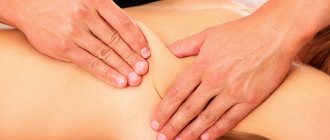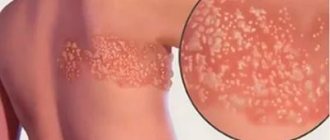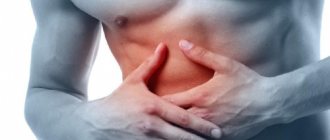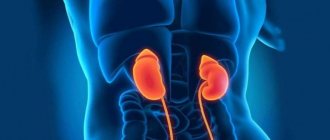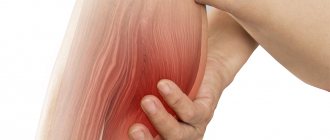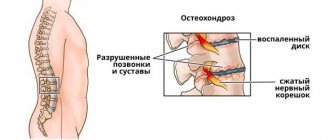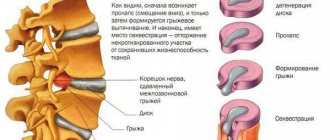Emerging pain in the heart with osteochondrosis can be reflected or true. In the first case, a person experiences unpleasant sensations spreading along the pinched nerve fiber of the roots responsible for the innervation of the intercostal muscles on the left side. In the second case, the situation is much more serious and develops against the background of damage to the radicular or cranial nerves responsible for the innervation of the heart muscle, pacemaker, coronary blood vessels or the formation of the vagus nerve.
More often, pain in the heart is recorded with thoracic osteochondrosis, since the radicular nerves responsible for the innervation of the intercostal muscles and sternum are subject to compression in this type of disease. Also, if the intervertebral disc is damaged in the thoracic region, an inflammatory process may occur that affects the intercostal muscles. The second factor of negative influence is the static tension of the muscular frame of the back, which tries to compensate for the shock-absorbing load that the damaged intervertebral disc cannot cope with.
The pain in the heart that occurs with cervical osteochondrosis is dangerous because it is often associated with damage to the paired cranial nerves. One of these pairs is responsible for the parasympathetic nervous system, which ensures the performance of the myocardial muscle and regulates the work of the pacemaker. The second pair is responsible for the formation of the vagus nerve, which also regulates cardiac activity and controls the volume of arterial blood released into the systemic circulation. If this work is disrupted, a primary form of vascular heart failure may develop.
Damage to the radicular nerves in the lower structures of the cervical spine leads to disruption of the innervation of the coronary vascular bed. This can contribute to the development of coronary heart disease, acute myocardial infarction, etc.
Pain in the heart area that occurs with osteochondrosis is a reason to urgently seek medical help. It is necessary to get an appointment with a vertebrologist or neurologist as soon as possible. Only an experienced doctor will be able to exclude the development of cardiac pathology and prevent negative consequences, such as aortic thrombosis, acute myocardial infarction, coronary artery stenosis, etc.
In Moscow, you can make an initial free appointment with a neurologist at our manual therapy clinic. To do this, just call the administrator and agree on a time convenient for your visit. During the free consultation, the doctor will conduct a full examination, make a preliminary diagnosis, and give individual recommendations for subsequent examination and treatment.
How does osteochondrosis affect the heart?
If there are several factors of how osteochondrosis affects the heart, they are divided into external and internal. An external factor of negative influence is the constant use of non-steroidal anti-inflammatory drugs, which are necessary for pain relief and relief of acute symptoms of this disease. These pharmacological agents act negatively both on the hematopoietic system, triggering the production of defective red blood cells by bone marrow structures, and on the epithelial layer inside the vascular bed. Long-term use of non-steroidal anti-inflammatory drugs increases the aggregation (tendency to stick together) of platelets, which contributes to the formation of blood clots in the coronary blood supply (this is the main cause of the development of acute myocardial infarction). The ability of red blood cells to transport oxygen changes, so the tissues of the heart muscle suffer from constant oxygen starvation.
Internal factors of the negative impact of osteochondrosis on the heart are:
- disruption of the process of innervation of the vascular bed, resulting in its spasm, alternating with prolapse, which entails instability of the blood supply to the myocardium;
- compression of the radicular nerves responsible for the performance of the intercostal muscles - as a result, the breathing process is disrupted and a secondary form of oxygen deficiency may develop, the biochemical parameters of gas exchange change;
- development of posterior vertebral artery syndrome, which leads to a significant deterioration in the blood supply to the medulla oblongata, where the respiratory center is located;
- compression of the cranial nerves responsible for the formation of the vagus nerve and solar plexus - this entails disturbances in heart rhythm, dislocation of the ventricles and atria, disruption of hemodynamics within the heart muscle and in the pulmonary circulation.
Other negative factors include a forced sedentary lifestyle, as the patient tries to avoid increased physical activity in case of severe pain. A secondary change in posture due to static tension in the muscular frame of the back can lead to curvature of the spine and compression of the heart muscle due to deformation of the chest.
Check yourself!
Determining what kind of pain arose in the left side of the chest is quite simple. With osteochondrosis, the pain usually does not go away for hours. What about hours - weeks and months! At the same time, it either intensifies for 1–3 days, then subsides.
With angina pectoris, the heart pain is short-lived and goes away after 3-5 minutes, especially when taking nitroglycerin. Moreover, it is in no way connected with physical activity, but makes itself felt when taking a deep breath, making sharp turns or changing body position.
But most importantly, if neurological pain is temporarily relieved by analgesics, then for heart patients these drugs are like a poultice for the dead. However, long-term use of analgesics can lead to the development of drug-induced gastritis and even gastric ulcers, so you should not abuse them.
Ointments containing bee or snake venom have a very good effect. They perfectly relax muscles and increase the elasticity of ligaments. After applying the ointment, the chest should be bandaged with a large towel or woolen scarf. Muscle relaxants are prescribed to relax spasmed muscles. In especially severe cases, novocaine or lidocaine blockades are used.
Can osteochondrosis radiate to the heart?
Many patients are concerned about the question of whether osteochondrosis can radiate to the heart and for what reasons this happens. Yes, degenerative dystrophic disease of the intervertebral discs can cause vague pain in the heart area, both due to direct influence and irradiation of the pain syndrome.
Osteochondrosis is a disease in which the destruction of intervertebral discs occurs. They are a kind of protective structural parts that ensure uniform distribution of the shock-absorbing load on the spine during movement and static position of the human body. The intervertebral disc consists of a dense fibrous membrane (annulus) and an internal pulposus (nucleus pulposus). These structures do not have their own circulatory network. They receive large amounts of fluid and nutrients dissolved in it during diffuse exchange with surrounding muscle tissue.
If the muscular frame of the back, collar area and neck is not subjected to regular physical activity, then the diffuse nutrition of the intervertebral disc is disrupted. The fibrous ring becomes dehydrated and loses its elasticity. Numerous cracks appear on its surface, which are filled with deposits of calcium salts. This is the initial stage of the development of osteochondrosis.
At the next stage, the intervertebral disc loses its physiological height and does not provide protection for the radicular nerves from compression of the adjacent vertebral body and osteophytes developing on their surface. It is at this stage that pain irradiates (spreads) to the heart area.
Disruption of the innervation of the coronary bloodstream, posterior vertebral artery syndrome, infringement of the vagus nerve at its base - these complications, provoking serious pathologies of the cardiovascular system, are formed already at the third and fourth stages of osteochondrosis of the cervical and thoracic spine.
Expert advice
If there is severe pain behind the sternum, which radiates to the arm, under the shoulder blade and is accompanied by shortness of breath, I advise you not to panic.
You need to sit or lie down and try to relax. If it does not go away after taking Nitroglycerin, Validol or Corvalol, you need to call an ambulance - it could be a heart attack. A few words about osteochondrosis: destructive changes in the spine cannot be cured. But it is quite possible to significantly improve the quality of life and slow down the progression of the disease for many years. To do this I recommend doing the following:
- When sitting, you should choose a hard chair. Your back should rest completely on it.
- If the work involves a forced monotonous position, you should do a light warm-up every 2-3 hours.
- When reading, you need to use a book stand to prevent your head from tilting down.
- Play sports (swimming is best for the spine).
How to distinguish heart pain from osteochondrosis?
There is only one way to distinguish pain in the heart from osteochondrosis - an ECG examination, which records changes in the functioning of the heart muscle at the level of electrical impulses. An ECG is the initial stage of examination, which shows the presence of a focus of pathological changes in the structure of the heart muscle.
There are no ways to determine whether heart disease or osteochondrosis is present at home; all the tests described using nitroglycerin have one feature. It is important to understand that if acute myocardial infarction develops, taking this vasodilator drug does not reduce pain. To provide medical care to patients with advanced myocardial infarction, narcotic painkillers are given.
Of course, osteochondrosis in the heart area does not cause such intense pain. But it is quite difficult for the patient to determine this parameter subjectively. You can try to diagnose pain in the heart area with osteochondrosis using palpation. If, when pressing on the intercostal spaces or spinous processes of the spine, increased pain occurs, then there is a high probability that this is osteochondrosis. If the pain does not increase, then most likely it is caused by coronary vascular pathology.
Very often, osteochondrosis radiates to the heart, upper limb (with numbness of the little finger) and under the shoulder blade. When you try to raise your arm up, the pain increases. Confirmation of the diagnosis is carried out using x-rays of the cervical and thoracic spine.
Heart diseases that need to be excluded
Diseases associated with cardiac dysfunction often manifest themselves in the same way as osteochondrosis. Since some pathologies are acute, and in a neglected state can lead to organ failure and even death of a person, they should be considered in more detail.
IHD
The pain from angina pectoris (“angina pectoris”) lasts 15 minutes. It can be relieved by taking Nitroglycerin and is of a pressing, burning nature. It is provoked by psycho-emotional stress, but can develop as a result of physical activity. It is localized behind the sternum, extends to the arm, under the shoulder blade, left side of the neck, jaw.
A heart attack is characterized by severe pain, sweating, pale skin, blue discoloration of the nasolabial triangle, and shortness of breath develops. The duration of the episode ranges from 1-2 hours to several days. It is not relieved by anti-inflammatory drugs and Nitroglycerin; it causes fear in the patient (which is usually not observed even with severe exacerbation of osteochondrosis).
Pericarditis and myocarditis
With inflammation of the pericardium, the pain tends to increase and can last for several days. It is not relieved by nitrates and NSAIDs. Shortness of breath, cough, and tachycardia gradually develop. Unlike spinal lesions, when trying to assume a horizontal position the patient always experiences a worsening of the condition. You can read more about pericarditis and its symptoms here.
Myocarditis occurs against a background of general weakness: signs of the inflammatory process come first. The pain is often dull, aching, and cannot be relieved by taking painkillers. Tilting the body and turning the body does not change anything in the patient’s sensations.
VSD
Vegetative-vascular dystonia may resemble symptoms of osteochondrosis. Discomfort in the chest area and lack of air in this case occur both during exertion and at rest. Often an attack is preceded by a stressful situation. Improvement occurs after taking sedatives, or the pain goes away on its own, without any treatment. Often observed in people with a labile nervous system. At the same time, with this pathology, sleep disturbance, irritability, decreased performance, and dependence on weather conditions are noted.
What is VSD and how to live with it: the video at the link below will help you get rid of unnecessary medications and false predictions.
Thromboembolism and aortic aneurysm
When a pulmonary artery is blocked by a thrombus, the symptoms depend on the size of the lumen of the vessel excluded from the circulation. Often the pain resembles angina pectoris or a heart attack with typical irradiation in this case; less pronounced suffering can simulate a herniated nerve being pinched in the spinal column. But the difference from osteochondrosis is the ineffectiveness of anti-inflammatory therapy and accompanying symptoms (bulging neck veins, pallor, tendency to faint).
Acute and unbearable pain is often the main and main symptom of dissecting aortic aneurysm. It arises behind the sternum, spreads to the back, and can radiate to the abdomen and lower extremities, depending on the location of the lesion. Its intensity is not reduced by taking analgesics or NSAIDs, or by rest.
How does the heart hurt with osteochondrosis - symptoms
You need to know how the heart hurts with osteochondrosis, what distinctive signs can be used to identify this condition. First of all, you should pay attention to the primary and secondary symptoms - how the heart hurts with osteochondrosis, at what time the attack begins, what can provoke it, what remedies help stop it, etc.
Distinctive symptoms of heart pain with osteochondrosis include:
- development after prolonged static stress (sedentary work in one position);
- prolonged attacks lasting more than 3 hours (sometimes up to several days);
- feeling of stiffness in movements after sleep and prolonged stay in a static position;
- pain on palpation of the thoracic spine, intercostal spaces and sternum;
- difficulty when trying to raise a straight arm up;
- absence of rhythm disturbances (atrial fibrillation, extrasystole, etc.).
If the pain in the heart area is radiating, then there are no secondary signs of myocardial damage. These are swelling of the legs, pastyness of the face, cyanosis of the nasolabial triangle, shortness of breath, cough when trying to lie in bed in a horizontal position without raising the head end.
What to do with osteochondrosis and heart pain?
The first thing to do if pain occurs in the heart area due to osteochondrosis of the thoracic or cervical spine is to consult a neurologist. Only an experienced doctor can eliminate the risk of developing cardiovascular pathology. In most cases, cervical osteochondrosis and the heart are connected due to impaired innervation. Therefore, if you have a serious heart disease (coronary disease, atherosclerosis, vascular stenosis, angina pectoris, impaired intracardiac electrical conductivity, arrhythmia, etc.), then you should definitely examine the cervical spine for pinched cranial and radicular nerves . It is this circumstance that provokes most of the pathologies of cardiovascular diseases.
Also, osteochondrosis of the cervical spine can affect the heart with the development of posterior vertebral artery syndrome. This condition is also accompanied by arterial hypertension, dizziness, and frequent headaches.
It is necessary to treat cervical, thoracic osteochondrosis and the heart simultaneously - for this an individual course of manual therapy is being developed. If compression of the radicular nerves is detected, an experienced doctor will conduct several sessions of traction traction of the spinal column. This will stop all the negative consequences of osteochondrosis. Then a planned course of restoration of intervertebral discs will be carried out by enhancing the diffuse nutrition of their cartilage tissue. For these purposes the following can be used:
- reflexology (acupuncture) to activate biologically active points responsible for the regeneration of damaged cartilage tissue, increasing the vitality of the human body;
- osteopathy and massage, improving microcirculation of blood and lymphatic fluid, increasing the elasticity of all soft tissues, promoting the removal of calcium salts;
- therapeutic exercises and kinesiotherapy to restore the process of diffuse nutrition and increase the tone of the muscular frame of the back and collar area;
- physiotherapy, laser treatment, etc.
If you need treatment for osteochondrosis and pain in the heart area, then make an initial free appointment at our manual therapy clinic. An experienced doctor will make an accurate diagnosis and give individual recommendations for the treatment of the identified disease.
What diseases can cause symptoms resembling thoracic osteochondrosis?
The diagnosis of “osteochondrosis” is not always made justifiably; even the doctor cannot always figure out what is happening to the patient. Back pain often occurs due to other diseases:
- Myofascial pain syndrome. A common condition in which pain occurs as a result of constant spasm of the back muscles.
- Herniated intervertebral discs. They are rare in the thoracic region, but can also be the main cause of pain between the shoulder blades and neurological disorders.
- Injuries. If the injury was relatively mild - for example, a soft tissue bruise, a muscle strain - the symptoms of “osteochondrosis” bother you for some time and then go away on their own, even if no treatment has been carried out. Pain can also be caused by more serious injuries - for example, a compression fracture, vertebral subluxation.
In order to correctly understand the causes of back problems, the patient must be examined by an experienced doctor and a full examination must be carried out. All this can be done at the medical center International Clinic Medica24. In our clinic, high-quality medical care is available around the clock; you can contact the administrator at any time, including holidays and weekends, by calling +7 (495) 230-00-01.
Get a consultation with a doctor
Message sent!
expect a call, we will contact you shortly
When the manifestations of “osteochondrosis” begin to bother you, you need to carry out a correct, comprehensive diagnosis and understand the true causes of the symptoms that have arisen. They are not always located in the spine itself. This helps to prescribe the appropriate treatment and deal with the problem as quickly and effectively as possible.
At the Medica24 international clinic, you will be examined by an experienced neurologist, and you will be prescribed all the necessary diagnostic methods.
